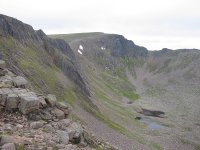Perennial snow is snow that falls in winter and lies throughout the summer without melting until the following winter's snowfalls. This new snow can lie on top of the unmelted old snow, and this is a condition for the formation of glaciers and icecaps.
There are two main areas in the Scottish mountains where perennial snow exists; Lochaber and the Cairngorms. The extent of long-lasting snow varies enormously from year to year and decade to decade; as an example see the three photographs of Coire an t-Sneachda in the northern Cairngorms below, taken by myself over a range of 27 years but at the same time of year (late June/early July):
The summers of 1983 and 1994 saw an unusually large extent of perennial snow throughout the Scottish mountains. From about 1995 until 2006 there was a noticeable reduction in this long-lasting snow cover (with the exception of summer 2000), with some years having no snow surviving until the following winter at all (a surprisingly uncommon occurence in the previous decades; since recorded observations began at the end of the 18th century, this has only happened five times, in 1933, 1959, 1996, 2003 and 2006).
Some attribute this to rising global temperatures; see the resources here for detailed discussions of this. In the years since 2010, this trend of declining perennial snow cover seems to have reversed somewhat.
The winter of 2009/2010 had very large snowfalls and low temperatures and may well have had the greatest amount of snow cover and depth in the Scottish mountains since the winter of 1978/1979. However, this large winter snowfall did not contribute to an increase in the number and extent of snowpatches remaining in the mountains throughout 2010, as numerous factors apart from winter snowfall levels contribute to snowpatch survival, including the prevailing wind direction throughout the winter months (which was predominantly from the north and north-east in 2010) and air temperatures and precipitation levels throughout the spring months.
The first half of the winter of 2010/2011 also had very large snowfalls and low temperatures, even more so than 2009/2010, although the second half of the winter was much less extreme. More precipitation came from the west this winter than the previous one, but this does not seem to have led to an increase in the depth, size and number of snowpatches lasting throughout 2011.
The winter of 2011/2012 had a low amount of snowfall but there were large snowfalls in the spring months of April and May 2012, leading to an unusually extensive snow cover on the Scottish mountains into June.
The factors affecting the longevity of these snowpatches are complex and not always obvious.



